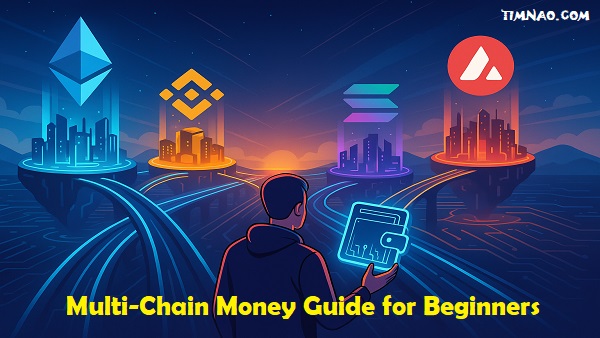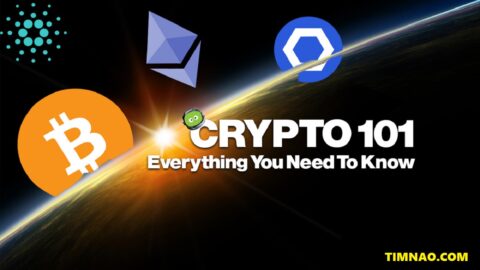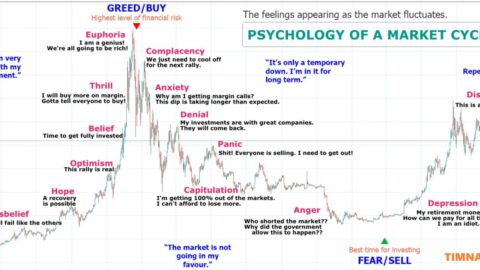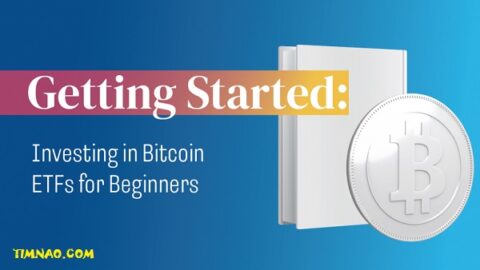Why Multi-Chain Money Is a Game-Changer for Your Crypto Future 🚀
Multi-chain money is rapidly redefining how we interact with blockchain technology. Gone are the days when being stuck on one chain limited your crypto opportunities. In today’s fast-moving Web3 world, the real power lies in your ability to move assets freely, earn across multiple ecosystems, and dodge sky-high gas fees—all through seamless cross-chain transactions.
Whether you’re just getting started or already trading crypto, embracing a multi-chain mindset opens doors to faster, cheaper, and smarter ways to manage your digital assets. Think of it as upgrading from a local wallet to a global vault—more options, better yields, and enhanced flexibility.
In this beginner-friendly guide, we’ll break down everything you need to know about multi-chain money, including how to get started, avoid risks, and unlock powerful tools that put you in control of your financial future—one chain at a time.
Ready to level up? Let’s dive in 👇
📚 Table of Contents
- 🌐 Why Multi-Chain Money is the Future
- 🔁 What Are Cross-Chain Transactions (and Why They Matter)
- 🛠️ How Cross-Chain Bridges Work in Simple Terms
- 🧭 Step-by-Step: How to Make Your First Cross-Chain Transfer
- 🔒 Safety First: How to Secure Cross-Chain Transfers
- 💸 7 Real-World Opportunities You Unlock with Multi-Chain Money
- 🚀 Emerging Tools for Effortless Blockchain Interoperability
- 🔮 Final Thoughts: Future-Proof Your Crypto Journey
🌐 Why Multi-Chain Money is the Future
Multi-chain money is rapidly transforming how crypto users interact with blockchain ecosystems. In the past, being loyal to one chain (like Ethereum or Bitcoin) meant limitations—slow transactions, high gas fees, and fewer DeFi options. But with the rise of multi-chain technology, these barriers are falling fast.
In 2025, the crypto world is no longer a collection of isolated islands. Instead, it’s evolving into a network of interconnected blockchains, where you can move assets freely, tap into higher yields, and reduce fees—all by leveraging cross-chain transactions.
Whether you’re a DeFi enthusiast, NFT collector, or just a long-term HODLer looking for better utility, multi-chain money gives you the tools to break free from chain-specific limitations and grow your crypto in smarter, more secure ways.
In this comprehensive beginner’s guide, you’ll learn how to make your first cross-chain transfer, secure your assets, avoid common pitfalls, and unlock real-world opportunities across different blockchains.
🔁 What Are Cross-Chain Transactions (and Why They Matter)
A cross-chain transaction is the process of moving crypto assets from one blockchain to another. For example, transferring USDT from Ethereum to Binance Smart Chain (BSC) to take advantage of lower gas fees or better staking options.
Why does this matter?
Because sticking to a single chain:
- Limits your earning potential
- Exposes you to higher transaction costs
- Restricts access to DeFi apps and NFTs exclusive to other blockchains
With cross-chain compatibility, you get the best of all worlds:
- Trade faster on Solana
- Stake with lower fees on BSC
- Mint NFTs on Polygon
- Access lending pools on Avalanche
Just like using multiple currencies while traveling, multi-chain access means more flexibility, fewer restrictions, and greater freedom in your crypto journey.
🛠️ How Cross-Chain Bridges Work in Simple Terms
A crypto bridge is like a digital tollbooth that helps you transfer tokens between two different blockchains. It doesn’t literally move your tokens—instead, it locks them on the original chain and issues a “wrapped” version on the target chain.
Here’s a beginner-friendly analogy:
Think of sending ETH from Ethereum to Avalanche like parking your real car (ETH) in a garage and receiving a rental car (wrapped ETH) on the other side. The rental performs the same, but it’s compatible with the new environment (Avalanche). When you’re done, you return the rental, and your real car is unlocked.
There are two main types of bridges:
- Centralized Bridges (e.g., Binance Bridge): Operated by a single entity, faster, but relies on trust.
- Decentralized Bridges (e.g., Portal Bridge, Multichain, Hop Protocol): Trustless and open-source, but sometimes slower.
Common cross-chain bridge platforms:
- ChainPort
- Across Protocol
- Synapse Protocol
- Stargate Finance
- LayerZero – a messaging layer used by several bridges
Understanding how these bridges work is crucial before using them. Always ensure the bridge is reputable and widely adopted before sending funds.
🧭 Step-by-Step: How to Make Your First Cross-Chain Transfer
Here’s a beginner-friendly walkthrough using Multichain:
- Choose Your Wallet
- Use a non-custodial wallet like MetaMask or Trust Wallet
- Go to the Bridge Site
- Visit a platform like Multichain, Portal Bridge, or Synapse
- Connect Your Wallet
- Click “Connect Wallet” and approve the connection
- Choose Chains & Token
- Select the chain you’re sending from (e.g., Ethereum) and to (e.g., Avalanche)
- Choose the token (e.g., USDT, ETH, DAI)
- Enter the Amount and Confirm
- Input how much you want to bridge
- The platform will show you estimated fees and expected arrival time
- Approve and Transfer
- Confirm two transactions: token approval and bridging transaction
- Wait for Confirmation
- Depending on network traffic, your funds may appear in 1–10 minutes
- Add the Destination Token to Wallet
- On some chains (like Polygon), you may need to “add token” manually to see it in your wallet
✅ Tip: Start with a small test transaction to avoid costly errors.
🔒 Safety First: How to Secure Cross-Chain Transfers
Cross-chain transactions offer freedom and flexibility—but they also come with new security risks. Since you’re often relying on third-party bridges or smart contracts, a single mistake can lead to the loss of your funds. Fortunately, with a few best practices, you can protect your crypto and enjoy the benefits of multi-chain money safely.
🧩 Understand the Risk Factors
Before using any bridge, you need to recognize the three most common risk zones:
- Fake Bridge Websites: Scammers often create lookalike versions of real bridge platforms.
- Smart Contract Bugs: Even trusted bridges can have vulnerabilities in their code.
- Rogue Validators or Exploits: Especially on new or underdeveloped chains, security might be weak.
💡 Always assume you’re your own bank. There’s no “undo” button in crypto.
🛡️ Best Practices for Safe Cross-Chain Transfers
1. Double-Check the URL
Use only the official websites of bridges, ideally bookmarked. Don’t rely on search results or links from social media.
✅ Use sites like:
- DefiLlama Bridges to discover verified cross-chain platforms.
2. Start with Small Test Transfers
Never send your entire balance in one go. Always start with a small amount (e.g., $5-$10) to ensure everything works as expected.
3. Use Reputable Wallets and Extensions
Install only trusted wallet extensions like MetaMask, and keep your wallet software updated. Avoid using wallets that haven’t been audited or widely adopted.
4. Monitor Gas Fees and Confirmations
If a transaction takes longer than expected, check blockchain explorers like:
Delays can happen, but large gaps may signal network congestion or an error.
5. Enable Wallet Notifications and Multi-Factor Security
Use features like email alerts, 2FA (Two-Factor Authentication), and hardware wallet confirmations for added protection.
6. Never Share Private Keys or Seed Phrases
Bridges will never ask for your private key or seed phrase. If they do, it’s a scam. Full stop.
🧠 Pro Tip:
Use a hardware wallet like Ledger or Trezor to add another layer of protection. They physically verify transactions, keeping your keys offline—even when bridging.
🚫 Avoiding Common Scams
Scammers evolve quickly in crypto. Here’s what to watch out for:
- Fake “support” agents on Discord or Telegram
- Links that auto-redirect to malicious dApps
- Telegram bots pretending to confirm bridge activity
✅ When in doubt, pause. Research. Ask in official project channels—not random DMs.
💸 7 Real-World Opportunities You Unlock with Multi-Chain Money
Once you master cross-chain transactions, the doors to powerful new opportunities swing wide open. Let’s explore the real-world benefits you can unlock by going multi-chain.
1. Arbitrage Trading Across Chains
Prices of the same token can vary across blockchains. For example, USDC on Arbitrum may trade slightly lower than on Ethereum during congestion.
By bridging funds between chains and executing quick buy-low-sell-high trades, you can profit from these price gaps.
💡 Tools to monitor:
- DexScreener
- 1inch Aggregator
- Jupiter Aggregator (for Solana)
2. Yield Farming on Lower-Fee Chains
Ethereum gas fees can eat into your profits. But many DeFi protocols like Aave, Curve, and SushiSwap also exist on:
- Arbitrum
- Optimism
- Avalanche
- Fantom
Using cross-chain bridges, you can access the same strategies at a fraction of the cost.
3. Accessing Exclusive DeFi Ecosystems
Each chain has its unique protocols:
- Polygon: Known for fast NFT minting
- BSC: Home to high-yield, risk-tolerant farming
- Solana: Fast, low-cost DeFi and NFT tools
Instead of choosing one, multi-chain users benefit from all.
4. Securing Assets on More Stable Chains
When a blockchain is experiencing high volatility, regulatory crackdowns, or security concerns, you can move assets to more stable or regulated chains, protecting your funds.
Examples:
- Move tokens from Fantom to Ethereum if there’s exploit risk
- Use USDC on Base (built by Coinbase) for added credibility
5. Participating in Multi-Chain Airdrops
Many projects reward early cross-chain adopters with airdrops. Notable examples:
- LayerZero
- StarkNet
- zkSync
Being active across chains increases your chance of free token rewards, just by using bridges and interacting with new ecosystems.
6. NFT Flexibility and Marketplace Access
You may want to buy NFTs on Solana but only hold ETH. Or mint cheaper on Polygon and sell on Ethereum’s OpenSea.
Multi-chain money lets you:
- Mint on low-fee chains
- Trade on high-volume platforms
- Bridge assets as needed
💡 Projects like Magic Eden and OpenSea now support multiple chains, making NFT interoperability easier than ever.
7. Passive Income from Cross-Chain Liquidity
Some protocols now reward you for providing liquidity across chains—not just on one.
Examples:
- Stargate Finance: Earn STG tokens by providing bridge liquidity
- Thorchain: Cross-chain swaps with yield potential
With the right knowledge, your assets can earn on multiple fronts—no matter where they’re bridged.
🚀 Emerging Tools for Effortless Blockchain Interoperability
The backbone of multi-chain money is interoperability—the ability for blockchains to communicate with each other, share data, and transfer assets securely. While traditional bridges have led the way, several powerful tools and protocols are now making cross-chain activity faster, safer, and more efficient for beginners.
Here are some of the most innovative cross-chain tools and platforms you should explore to stay ahead in 2025:
1. LayerZero: The Internet of Blockchains
LayerZero is a cross-chain communication protocol enabling smart contracts on different blockchains to talk to each other directly. Unlike traditional bridges, LayerZero doesn’t just move tokens—it enables true omnichain applications, where assets and logic operate across chains seamlessly.
✅ Use cases:
- Cross-chain DEXes (like Stargate)
- NFT projects with multi-chain presence
- DeFi apps that interact with assets on multiple networks
2. Stargate Finance: One-Click Cross-Chain Swaps
Built on LayerZero, Stargate allows users to transfer tokens between chains in a single transaction. There’s no need to wrap or unwrap tokens—just select the source and destination, and Stargate handles the rest.
✅ Supported chains: Ethereum, Arbitrum, Optimism, BNB Chain, Polygon, Avalanche, Fantom, and more
Beginner-friendly with clear UI, low fees, and strong liquidity pools, Stargate is becoming the go-to for easy asset bridging.
3. THORChain: Truly Decentralized Swaps
THORChain is one of the only platforms allowing native token swaps across L1 chains—no wrapped tokens involved. You can swap Bitcoin directly for Ethereum, or Litecoin for BNB, without using an intermediary.
✅ Why it’s powerful:
- No need for centralized exchanges
- Ideal for long-term holders
- Built for true self-custody and decentralization
It’s like having a decentralized version of Binance, with none of the custodial risk.
4. Synapse Protocol: Advanced Cross-Chain DEX
Synapse offers secure, fast bridging and asset swaps between over 20 chains. It supports both EVM and non-EVM chains and powers decentralized exchanges that work across networks.
✅ Bonus:
- Developers can build on Synapse’s SDK
- You can swap tokens or bridge stablecoins in just a few clicks
Synapse is ideal for those who want more control and versatility when moving assets.
5. Across Protocol: Speed Meets Simplicity
Across is a liquidity-optimized bridge built for fast and low-cost transfers, primarily between Ethereum and Layer 2s like Arbitrum, Optimism, and Base.
✅ Key features:
- Instant bridge confirmations
- Low slippage
- Strong security architecture
Across is best suited for users bridging between high-throughput Layer 2 networks, especially for small-to-mid-size transactions.
6. Composable Finance: Interoperability for DeFi Builders
Composable is focused on enabling cross-chain functionality for DeFi apps via IBC (Inter-Blockchain Communication). It connects Polkadot, Cosmos, Ethereum, and more—giving developers tools to build universal dApps.
✅ Best for:
- Power users
- Developers
- DeFi enthusiasts who want to explore emerging ecosystems beyond Ethereum
7. ChainPort: Enterprise-Grade Bridge with Security Focus
ChainPort offers fast token bridging across multiple blockchains with an emphasis on audit transparency and insurance. It’s trusted by many Web3 projects looking for reliable cross-chain tools.
✅ Features:
- Port tokens across EVM chains in minutes
- Institutional-grade infrastructure
- Trusted by projects like ShibaSwap and Saito
These tools are part of a growing movement to break blockchain silos, giving you better control over your digital assets and enabling richer, more profitable experiences across networks.
💡 Pro Tip: Start experimenting with smaller transactions on each of these platforms to learn their unique strengths before committing large funds.
🔮 Final Thoughts: Future-Proof Your Crypto Journey
As the crypto world continues to evolve, one thing is clear: multi-chain money isn’t just a trend—it’s the future of digital finance. The age of being tied to a single blockchain is fading. Interoperability is empowering investors, builders, and everyday users to move freely, access better opportunities, and control their financial future like never before.
Whether you’re just dipping your toes into crypto or you’ve been around for a while, here’s what you should take away:
🚦 Start Small, Learn Fast
The best way to get comfortable with multi-chain money is to practice hands-on. Bridge a small amount, use different chains, and experiment with new tools. Each action builds confidence.
💡 Always Prioritize Security
No amount of profit is worth a preventable loss. Stick to audited bridges, double-check URLs, and use cold storage when possible. Education is your best armor in Web3.
💸 Seek Out Emerging Opportunities
Don’t limit yourself to Ethereum or Bitcoin. Some of the most lucrative opportunities—from early-stage DeFi farming to new NFT markets—live on chains like Avalanche, Polygon, or Solana. Multi-chain access means multi-stream profits.
🔄 Stay Agile, Stay Updated
Crypto changes fast. Platforms evolve, risks emerge, and new bridges get launched. Follow trusted sources like:
Keep learning, testing, and adapting. That’s how you survive—and thrive—in a decentralized economy.
✅ Your Next Steps
- Create or update your non-custodial wallet (e.g., MetaMask or Trust Wallet)
- Choose a bridge like Stargate or Synapse to try a test transfer
- Explore new DeFi apps on Avalanche, Polygon, BNB Chain, or Base
- Follow crypto security best practices to protect your funds
- Revisit this guide when exploring new chains or tools
With multi-chain money, you’re not just investing in tokens—you’re investing in the ability to move, adapt, and grow in any direction the blockchain world takes you. Master it now, and you’ll be ready for the decentralized future ahead.
⚠️ Disclaimer
The content provided in this article is for educational and informational purposes only and should not be considered financial, investment, or legal advice. Cryptocurrency investments involve substantial risk and may not be suitable for all investors. Always conduct your own research and consult with a licensed financial advisor before making any investment decisions.
While we strive to provide accurate and up-to-date information, the rapidly evolving nature of the crypto industry means tools, platforms, and opportunities mentioned may change over time. Use any third-party services or protocols mentioned in this guide at your own discretion and risk.
We do not endorse or guarantee the performance, security, or reliability of any specific crypto projects, wallets, or bridging platforms referenced in this article.









